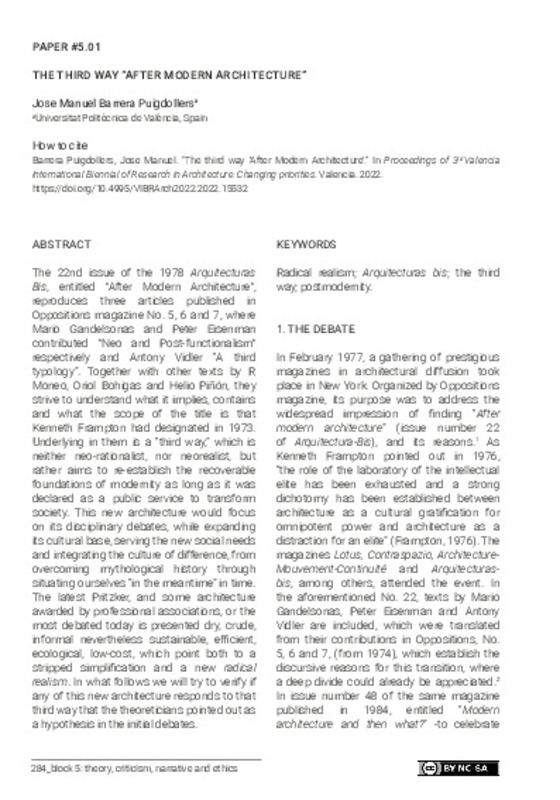JavaScript is disabled for your browser. Some features of this site may not work without it.
Buscar en RiuNet
Listar
Mi cuenta
Estadísticas
Ayuda RiuNet
Admin. UPV
The third way “After Modern Architecture”
Mostrar el registro sencillo del ítem
Ficheros en el ítem
| dc.contributor.author | Barrera Puigdollers, Jose
|
es_ES |
| dc.date.accessioned | 2023-12-19T08:42:37Z | |
| dc.date.available | 2023-12-19T08:42:37Z | |
| dc.date.issued | 2023-05-22 | |
| dc.identifier.isbn | 9788413960265 | |
| dc.identifier.uri | http://hdl.handle.net/10251/200898 | |
| dc.description.abstract | [EN] The 22nd issue of the 1978 Arquitecturas Bis, entitled "After Modern Architecture", reproduces three articles published in Oppositions magazine No. 5, 6 and 7, where Mario Gandelsonas and Peter Eisenman contributed "Neo and Post-functionalism" respectively and Antony Vidler “A third typology”. Together with other texts by R Moneo, Oriol Bohigas and Helio Piñón, they strive to understand what it implies, contains and what the scope of the title is that Kenneth Frampton had designated in 1973. Underlying in them is a “third way,” which is neither neo-rationalist, nor neorealist, but rather aims to re-establish the recoverable foundations of modernity as long as it was declared as a public service to transform society. This new architecture would focus on its disciplinary debates, while expanding its cultural base, serving the new social needs and integrating the culture of difference, from overcoming mythological history through situating ourselves “in the meantime” in time. The latest Pritzker, and some architecture awarded by professional associations, or the most debated today is presented dry, crude, informal nevertheless sustainable, efficient, ecological, low-cost, which point both to a stripped simplification and a new radical realism. In what follows we will try to verify if any of this new architecture responds to that third way that the theoreticians pointed out as a hypothesis in the initial debates. | es_ES |
| dc.format.extent | 14 | es_ES |
| dc.language | Inglés | es_ES |
| dc.publisher | Editorial Universitat Politècnica de València | es_ES |
| dc.relation.ispartof | Proceedings - 3rd Valencia International Biennial of Research in Architecture, VIBRArch | |
| dc.rights | Reconocimiento - No comercial - Compartir igual (by-nc-sa) | es_ES |
| dc.subject | Radical realism | es_ES |
| dc.subject | Arquitecturas bis | es_ES |
| dc.subject | The third way | es_ES |
| dc.subject | Postmodernity | es_ES |
| dc.title | The third way “After Modern Architecture” | es_ES |
| dc.type | Capítulo de libro | es_ES |
| dc.type | Comunicación en congreso | es_ES |
| dc.identifier.doi | 10.4995/VIBRArch2022.2022.15532 | |
| dc.rights.accessRights | Abierto | es_ES |
| dc.contributor.affiliation | Universitat Politècnica de València. Departamento de Proyectos Arquitectónicos - Departament de Projectes Arquitectònics | es_ES |
| dc.contributor.affiliation | Universitat Politècnica de València. Escuela Técnica Superior de Arquitectura - Escola Tècnica Superior d'Arquitectura | es_ES |
| dc.description.bibliographicCitation | Barrera Puigdollers, J. (2023). The third way “After Modern Architecture”. Editorial Universitat Politècnica de València. 284-297. https://doi.org/10.4995/VIBRArch2022.2022.15532 | es_ES |
| dc.description.accrualMethod | OCS | es_ES |
| dc.relation.conferencename | 3rd Valencia International Biennial of Research in Architecture, VIBRArch | es_ES |
| dc.relation.conferencedate | Noviembre 09-11, 2022 | es_ES |
| dc.relation.conferenceplace | Valencia, España | es_ES |
| dc.relation.publisherversion | http://ocs.editorial.upv.es/index.php/VIBRArch/VIBRArch2022/paper/view/15532 | es_ES |
| dc.description.upvformatpinicio | 284 | es_ES |
| dc.description.upvformatpfin | 297 | es_ES |
| dc.type.version | info:eu-repo/semantics/publishedVersion | es_ES |
| dc.relation.pasarela | OCS\15532 | es_ES |








